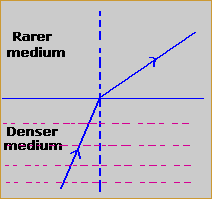Law of refraction.

Do you know why light rays moves away from the perpendicular line weather it refracted from denser medium to a rarer medium and vice-versa?
No vote yet
1 vote
Easy Math Editor
This discussion board is a place to discuss our Daily Challenges and the math and science related to those challenges. Explanations are more than just a solution — they should explain the steps and thinking strategies that you used to obtain the solution. Comments should further the discussion of math and science.
When posting on Brilliant:
*italics*or_italics_**bold**or__bold__paragraph 1
paragraph 2
[example link](https://brilliant.org)> This is a quote# I indented these lines # 4 spaces, and now they show # up as a code block. print "hello world"\(...\)or\[...\]to ensure proper formatting.2 \times 32^{34}a_{i-1}\frac{2}{3}\sqrt{2}\sum_{i=1}^3\sin \theta\boxed{123}Comments
Think of the light ray as a rectangle. We know how the indices of the two media compare: that is, if nr is the index of the rarer medium and nd is the index of the denser medium, we know that nr<nd, which means that the speed of the light ray in the rarer medium is faster than the speed of the light ray in the denser medium. When it enters the rarer medium with index nr, the portion that is in the rarer medium will move faster than the portion that is still in the denser medium, so it effectively "pivots" on the boundary.
I don't know if this is the correct way to explain it, but it does help me visualize it more easily. :P
When it moves from R to D...it moves towards normal so why have you stated "ight rays moves away from the perpendicular line weather it refracted from denser medium to a rarer medium and vice-versa"
As an EM wave enters a material, it interacts with it. The electrical part re-orients the electrical dipoles and the magnetic part re-orients the magnetic dipoles. The material re-orients, stretches, or whatever it does in response, adding it's own polarity to the wave, enhancing it, but slowing it and diminishing it as the material response time becomes a factor. We boil all these effects into the complex numbers of permittivity (loosely known as the dielectric constant, strictly, the dielectric constant is the real part of permittivity) and permeability.